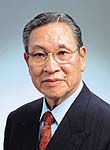
Vice Chairman, Keidanren
Chairman of the Board, Sony Corporation
 |
Norio Ohga Vice Chairman, Keidanren Chairman of the Board, Sony Corporation |
As of January 6, 2001, the central government ministries of Japan will be drastically reorganized, changing from 23 ministries to 13. Although a few problems concerning administrative reform still remain, it is certainly a great improvement and it can safely be said that this is the biggest governmental reform since the postwar period.
At the same time, decentralization is also a key element of reform, not only for the central government but also for local government. At present, there are 3,229 local municipalities but, under the Ministry of Home Affair's supervision, by the end of this year, each prefecture is going to make a blueprint (Outline for the Promotion of Mergers of Local Municipalities) for the merger of local municipalities.
As a result of the rapid economic growth in the post-world war period, the transportation infrastructure of Japan has been improved significantly. In addition, the recent accelerated development of information technology and the widespread use of the Internet have multiplied the variety of people's lifestyles and economic activities. In order to keep pace with these changes, the role and the size of local government should be expanded. This will not only enable local government to work more efficiently, but will also help to restructure the giant budget deficits, which currently exist. Now each local government owns its own office building, parliament and cultural public facilities, (such as orchestra halls). This leads to excess capacity and inefficiency. The balance of local government's debt was 187 trillion yen at the end of fiscal year 2000, and the total balance of the debt of both the local and central government is expected to top 645 trillion yen.
Today, voluntary community mergers are being promoted (based on the Law Concerning Special Measures for the Merger of Municipalities) in order to make mergers much easier. But, during the 1950s, drastic merger programs were undertaken and the number of local municipalities was reduced from about 10,000 to 3,472, that means they were reduced by two-thirds. At that time reform was promoted with the government's strong leadership and a clear target, grounded on the Cabinet meeting's agreement, stated that the number of local municipalities would be reduced by two-thirds. This was done to ensure that the primary schools could be run independently. Since then, there have been no significant mergers, because the reform relies on voluntary activities by the municipalities themselves.
Further centralization by local government will enable those bodies to offer more comprehensive services. It is difficult for local government to obtain true independence and autonomy if their sources of revenue derive only from the central government, such as the tax allocated to local governments. It is vital for local government to obtain their-own sources of revenue to achieve greater independence. Moreover, after mergers of local municipalities have been achieved, it will become necessary to discuss the integration of prefectures. In order to advance to genuine decentralization, the integration of prefectures and the introduction of the concept of these new units of local government (Do and Shu) will be key issues for discussion. In this regard, promotion of local municipal mergers is certainly a very important first step.